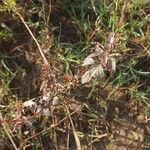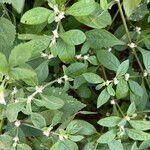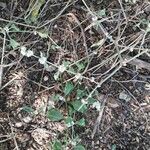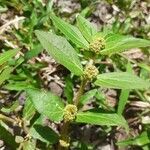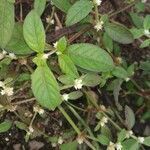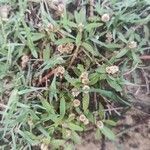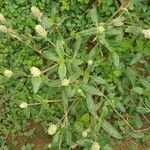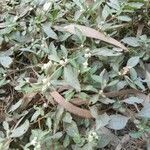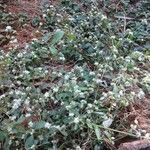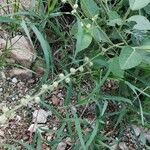Herb, perennial or under unfavourable circumstances short-lived, often pluricaulous, 10-100 cm long; taproot robust; stem either erect, ascending or creeping and solid, (or, in inundated localities, floating and in the lower part fistular), green or more or less tinged with purple, on 2 opposite sides with a longitudinal row of hairs, across the nodes with a transverse row of hairs, otherwise glabrous; hairs articulate, smooth. Leaves variable as to shape and size, varying from linear-lanceolate via oblong to oval or obovate, acute at the base, acute, obtuse or rounded at the apex, green, glabrous or thinly and finely pilose, ¾-15 cm by ¼-3 cm, in wet localities comparatively large, in dry localities much smaller; petiole 1-5 mm. Heads 1-4 in the axil of present or fallen leaves, sessile but by the fall of lower flowers often spuriously peduncled, at first globose, growing more cylindrical with age, ½-1½ cm long; rachis densely white-hairy; bracts and bracteoles not or shortly acuminate, glabrous, white, persistent after the fall of the flowers; bracts ⅔-1 mm; bracteoles 1-1½ mm. Tepals shortly acuminate or not, glabrous or on the back with few or several hairs, white or purplish, shining (in a living state), 1-nerved or only at the very base obscurely 3-nerved, after anthesis not hardening in the lower part, 2½-3 mm long. Filaments 5 of which only 3 antheriferous, ± ¾ mm long (basal cup included); anthers oval-oblong, 1/6-¼ mm; pseudo-staminodes subulate-filiform, entire, very minute, not exceeding filaments, often shorter. Style during anthesis very short, afterwards slightly lengthened. Fruit falling off with the perianth, obreniform, deeply emarginate, corky, dark brown, glabrous, 2-2¼ by 2½-3 mm; lobes finally longer than the interposed style.
Annual or perennial herb, terrestrial or sometimes shallow-water aquatic, creeping, trailing, scandent or erect, to 60 cm or more, usually smaller; stems ribbed, pubescent in 2 lines in grooves between ribs, or sometimes glabrous, rooting at lower nodes. Leaves of a pair sometimes unequal; petiole short, to 5 mm long; blade ovate, oblanceolate or elliptical, acute to obtuse and mucronulate at apex, cuneate and tapering to base, 1-6 x 0.5-1.5 cm, shallowly serrulate, glabrous on both sides or sparsely puberulent on midvein below. Inflorescence of axillary, congested, sessile, globose heads; heads 2-4 x 3-6 mm; bracts and bracteoles ovate, 0.3-0.8 mm long, acuminate, mucronate, hyaline, prominently 1-veined. Tepals white, hyaline, lance-ovate, narrowly ovate or elliptic-ovate, 1-2 mm long, acute, apiculate, slightly concave, glabrous, 1-veined; stamens 3, shorter than tepals, pseudostaminodia entire, or dentate at apex, shorter than to as long as filaments; style 0.1-0.2 mm long, stigma capitate. Utricle yellowish, bifacially compressed, obcordate, 1.5-2.0 x 1.5-2.2 mm, emarginate, much protruding from and exceeding tepals at maturity, with peg-like persistent style; seed brown or reddish-brown, cochleate-orbicular or lenticular, 1.0-1.2 mm wide, with a sharp margin, shining.
Herbs perennial, 10-45 cm tall. Stem ascending or creeping, green or somewhat tinged purple, striped, hairy, across nodes with a transverse row of hairs. Petiole 1-4 mm, glabrous or pilose; leaf blade linear-lanceolate, oblong-obovate, or ovate-oblong, 1-8 × 0.2-2 cm, glabrous or pilose, base attenuate, margin entire or slightly serrate, apex acute or obtuse. Heads 1-4, axillary, sessile, at first globose, later cylindric, 3-6 mm in diam. Flowers dense; rachis densely white hairy. Bracts and bracteoles white, glabrous, apex acuminate; bracts ovate-lanceolate, ca. 1 mm; bracteoles subulate, 1-1.5 mm. Tepals white, ovate, 2-3 mm, glabrous, with a vein, apex acuminate or acute. Stamens 3; filaments ca. 0.7 mm, connate into a cup at base; anthers oblong; pseudostaminodes subulate, shorter than stamens, margin entire, apex acuminate. Style very short; stigma shortly parted. Utricles enclosed in perianth, dark brown, obovoid, 2-2.5 mm. Seeds ovoid. Fl. May-Jul, fr. Jul-Sep. 2n = 34, 40.
Prostrate or decumbent puberulent or glabrous annuals or perennials, the sparsely branched stems to 60 cm. long. Leaves glabrous or sparsely villous below, elliptic, apically acute and mucronate, basally cuneate to attenuate, 1-4 cm. long, 0.5-1.5 cm. broad; petioles 1-5 mm. long, often winged. Inflorescences of white or pinkish globose heads, 2-4 mm. long, 2-4 mm. broad, sessile in the axils. Flowers perfect, the bracts and bracteoles subequal, acute, 1 mm. long or less; sepals 5, subequal, transparent, not indurate, 1-nerved, slightly concave, 1-1.5 mm. long; stamens 5, united below into a short tube, the pseudostaminodia entire, exceeded by the anthers, about equaling the filaments; ovary obovoid, style 1, 3-4 times as long as the minute capitate stigma. Fruit an indehiscent obcordate yellowish utricle, 1.5-2 nam. long, usually slightly exceeding the sepals; seeds yel-lowish or reddish brown, cochleate-orbicular, 1-1.2 mm. broad.
Decumbent perennial herb with stems to c. 50 cm long, usually at least partly rooting at lower nodes, often much-branched and with a longitudinal row of hairs on 2 opposite sides. Lvs usually shortly petiolate, 1-4-(6) cm × 2-8 mm, linear to narrow-oblong, narrow-elliptic or oblanceolate (shape may vary on the one plant), glabrous or almost so, entire or obscurely denticulate; base attenuate; apex obtuse to subacute. Fls in dense, sessile, axillary, ± globular heads, 5-8-(10) mm diam. Bract and bracteoles much < perianth, white or pinkish white, scarious. Tepals unequal, 2-3 mm long, white, scarious, with soft apex; longer tepals linear-lanceolate or lanceolate, acuminate; shorter tepals ± ovate, ± acute. Fertile stamens 2-3; staminodes minute. Utricle ± 1.5 × 2 mm, light brown, strongly compressed laterally, broadly obcordate; margin thickened. Seed c. 1 mm diam., shining.
A low lying and spreading herb which has many branches. It continues to grow from year to year. It has a strong taproot. The stem and branches are up to 60-100 cm long and near the ends there are 2 lines of hairs along the stem. The leaves are smooth and attached to the stem without a stalk. They are opposite. The leaves are 1-10 cm long and 0.2-2 cm wide. The flowers heads are white and 5 to 7 mm long. They grow along the plant and do not have flower stalks. It flowers all year round. The fruit are oval and compressed on the side. The seed is about 1.5 cm across. When plants are growing in water the stems become hollow and the plants float.
Herbs, annual or perennial, 2-6 dm. Stems procumbent, pubes-cent in lines, glabrate. Leaves sessile; blade elliptic to oblong or oblanceolate, 1.2-5 × 0.5-2.2 cm, apex obtuse to acute, glabrous. Inflorescences axillary, sessile; heads white, subglobose or ovoid, 0.5-1.1 cm; bracts keeled, ca. 1/2 as long as tepals. Flowers: tepals white, ovate to lanceolate, 2-3.5 mm, apex acuminate, hairs not barbed; stamens 5; anthers 3-5, globose; pseudostaminodes subulate, margins laciniate. Utricles included within tepals, sides exerted in mature fruit, greenish stramineous, obcordate, 1.3-1.7 mm, apex retuse. Seeds lenticular, 0.9-1.1 mm.
Perennial, hydrophytic herb, up to 0.6 m high. Stems procumbent, erect or scandent. Leaves with blade extremely variable in shape and size, narrowly linear-ovate, oblong or obovate-spathulate, 10-90 x 2-20 mm. Flowers: inflorescences subglobose, axillary solitary or in clusters; perianth segments all similar in form, 2.0-2.5 mm long, acute, shorter than fruit, white; Jul.-Jun. Fruit when ripe dark, thin-margined with only a narrow yellowish rim, almost as long to sometimes exceeding the 2.0-2.5 mm long perianth segments.
Annual or usually perennial herb; in drier situations with slender, more solid stems, prostrate, decumbent or erect, more or less much-branched, to c. 30 cm.; in wetter places ascending or most commonly prostrate with stems c. 0.1–1 m. long, rooting at the nodes, more or less fistular, with numerous lateral branches; when floating very fistular, the stems attaining a metre or more in length and over 1 mm. thick, with long clusters of whitish rootlets at the nodes.
Perennial, hydrophytic herb, up to 150 mm high. Stems procumbent or erect. Leaves with blade narrowly ovate, 20-70 x 3-12 mm. Flowers: inflorescences globose, axillary solitary or in clusters; bracts 4 mm long, acuminate, longer than fruit; perianth segments all similar in form, white; Jul.-Jun. Fruit when ripe yellowish with tumid margins on each side of seed, only about half length of the 30-40 mm long perianth segments.
Annual or perennial herb, up to 0.3 m high, prostrate or erect to floating or scrambling. Leaves opposite, entire, sessile or nearly so, apex rounded to pointed. Inflorescences in heads or short spikes, axillary, sessile. Tepals 4 or 5, free or concrescent at base. Fruit flattened, heart-shaped, indehiscent capsule. Seeds disc-like, 0.75-1.00 mm in diam.
Leaves extremely variable in shape and size, linear-lanceolate to oblong, oval, or obovate-spathulate, 1–9 (15) × 0.2–2(3) cm., blunt to shortly acuminate at the apex, cuneate to attenuate at the base, glabrous or thinly pilose, especially on the inferior surface of the midrib; petiole obsolete to c. 5 mm. long.
Inflorescences sessile, axillary, solitary or in clusters of up to c. 5, subglobose (slightly elongate in fruit), c. 5 mm. in diam.; bracts scarious, white, deltoid-ovate, mucronate with the excurrent pale midrib, glabrous, c. 0.75–1 mm. long; bracteoles similar, 1–1.5 mm., also persistent.
Stem and branches green to pink or purplish, with a narrow line of whitish hairs down each side of the stem and branches (at least when young) and tufts of white hairs in the branch and leaf axils, otherwise glabrous, striate, terete below, more or less tetragonous above.
Fruit glabrous, obcordate or cordate-orbicular, 2–2.5 mm. long, dark at maturity, strongly compressed with the margins each side of the seed not much thicker than the narrow, pale, yellowish keel, slightly longer to slightly shorter than the perianth.
Tepals oval-elliptic to lanceolate-ovate, equal, 1.5–2.5 mm. long, acuminate to rather blunt, white to pink-tinged, glabrous, shortly but distinctly mucronate with the stout, excurrent midrib, the margins often obscurely lacerate-denticulate.
Stamens 5 (2 filaments anantherous), at anthesis subequalling the ovary and style, the alternating pseudostaminodes resembling the filaments but usually somewhat shorter.
Prostrate, scandent or erect hydrophytic herb, up to 0.6 m high. Leaves lanceolate. Perianth segments 2.0-2.5 mm long, acute, shorter than fruit. Flowers white.
Prostrate or erect hydrophytic herb, up to 150 mm tall. Leaves lanceolate. Flower bracts 4 mm long, acuminate, longer than fruit. Flowers white.
Seed discoid, c. 0.75–1 mm. in diam., brown, shining, faintly reticulate.
Ovary strongly compressed, roundish, style extremely short.
